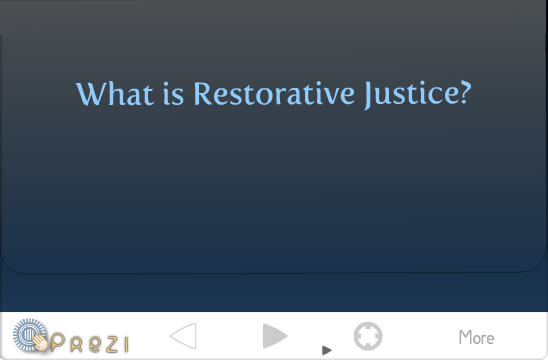Characteristics of the case
This case happened between two adolescent boys. The conflict lasted ten days and kept repeating on a daily basis. It is interesting that the offender was two years younger than the victim, and that his physical constitution was much weaker. Nevertheless, he continually teased, provoked and verbally maltreated his victim. It threatened to grow into something more serious, especially since the victim was a new inmate, surrounded by boys of this type for the first time, which produced considerable strain and also destabilised him.
We first dealt with this case according to the regular procedures at the institution. Individual meetings were held with both boys, explaining to both of them separately the position and condition of the other. Special attempts were made to awaken the offender’s feelings for the victim, to help him understand the victim’s position; while on the other side, I explained to the victim what type of boy he was dealing with, and what might be the motivations for his hostile behaviour. It helped only temporarily, but did not resolve the problem in the long run, and the situation continued. The victim was desperate and felt that the aggression against him was personal.
It seemed that there was no way out, and we decided to offer them an alternative method of resolving the conflict – mediation. I was happy to use mediation in this case, having in mind the balance of power, as both boys were going through a period of adjustment and accommodation to the institution’s requirements; this, to a certain extent, placed them in an equal position. The boys knew about mediation, so understood what was being offered.
The mediation process
The interview was conducted with the offender first. The boy, who had suffered emotionally in his childhood, growing up with no love and affection, and who was mentally unstable, reacted violently at first, as he usually did, saying that he had nothing to talk about to the victim. Being aware of this side of his character, I waited until he calmed down, and explained to him the advantages of this way of problem-solving, i.e. resolving the actual conflict. He accepted immediately.
After that, the interview with the victim took place. He could not wait to solve the problem and also accepted mediation immediately. He was a boy capable of talking openly about issues bothering him and could express his feelings well.
Mediation took place straight after the individual meetings. I was the sole mediator for the case. The boys were sitting facing each other, separated by a desk. I sat closer to the offender, knowing that he was likely to act out, rashly, abruptly and thoughtlessly. The victim started to talk first. He explained the main reason he was upset, and how he felt ‘in his heart’ when the boy sitting opposite was abusing him. I watched the offender’s reaction. First the colour of his face changed, then his chin trembled and his face muscles contracted. His breathing accelerated. It looked as if he was going into a hysterical crisis, so I touched him on the shoulder, telling him that everything would be OK. At that moment, he started to sob, and all the sorrow and misery of his life poured out uncontrollably. While he was sobbing inconsolably, I looked at the victim. His face showed an abundance of emotions: astonishment, dismay, fear, sympathy, sorrow. He could not believe what he was witnessing, that the offender had turned, in front of his eyes, into a boy who was anything but aggressor and offender. Some time later, the passions soothed. An agreement was made, and they both signed it.
The agreement and outcome
The offender did not apologise, but the agreement included promises that verbal provocations would not be repeated while the offender was in the institution. The agreement was followed up by personal officers and had not been broken at the time of writing.
On our way out, the victim approached me, saying:
“Officer, I cannot be cross with him any more, no matter what he does to me. I didn’t know he was so miserable.”
That is how this mediation ended. I could not avoid the feeling of sympathy and sorrow myself, though I have got used to various situations, after being on the staff in the institution for a long time.
Comment
What was important in this case was the victim’s perception. It was his perception that he was not the main actor in this story, and that he was chosen to be the object of verbal provocation only by chance. He realised that it was more the problem of the offender and he had understanding for his sorrow, his misery and his needs. Even if the offender himself did not learn very much about constructive problemsolving, the mediation was a success because the victim understood his position of being chosen by accident.
Once again, I saw proof of the fact that indirect explanation of other people’s feelings does not have the same power of apprehension, understanding and empathy as an authentic session of exchanging feelings. All talk about the feelings of the other is insignificant, until the moment you see it with your own eyes and experience it. And, once again, the victim had understanding for the offender and his motives, recognising that the offensive behaviour was not caused by external but internal factors. They originated in the offender’s need to take out his frustrations, which had accumulated for years.
Source: Marian Liebmann’s book, ‘Restorative Justice: How it works’ (2007, Jessica Kingsley Publishers)








No comments